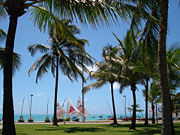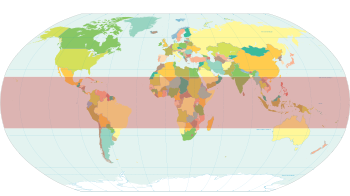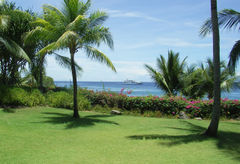Tropics
2008/9 Schools Wikipedia Selection. Related subjects: Geography
The tropics are the geographic region of the Earth where the sun passes through the zenith twice during the solar year (once as the sun appears to go north and once as it appears to go south). At the limits, called the tropics of Cancer and Capricorn, this occurs once at the relevant solstice.
This area is centered on the equator and limited in latitude by the Tropic of Cancer in the northern hemisphere, at approximately 23°26' (23.4°) N latitude, and the Tropic of Capricorn in the southern hemisphere at 23°26' (23.4°) S latitude. This region is also referred to as the tropical zone and the torrid zone (see geographical zone).
On the other hand, in the temperate zones, north of the Tropic of Cancer and south of the Tropic of Capricorn, the sun never reaches the zenith, always passing south (north) of it in the northern (southern) hemisphere.
The word "tropics" comes from Greek tropos meaning "turn", because the apparent position of the Sun oscillates between the two tropics with a period that defines the average length of a year.
Tropical seasons and climate
The seasons in the tropics are dominated by the movement of the tropical rain belt (or ITCZ), which oscillates from the northern to the southern tropics over the course of the year, thus causing the dry season and the wet season in turn.
Tropical is sometimes used in a general sense for a tropical climate that is warm to hot and moist year-round, often with the sense of lush vegetation. However, there are places in the tropics that are anything but "tropical" in this sense, with even alpine tundra and snow-capped peaks, including Mauna Kea, Mt. Kilimanjaro, and the Andes as far south as the northernmost parts of Chile and Argentina. There are also places in the tropics which are desert, with extreme heat, such as the Sahara Desert and Australian Outback.
Tropical ecosystems

Tropical plants and animals are those species native to the tropics. Tropical ecosystems may consist of rainforests, dry deciduous forests, spiny forests, desert and other habitat types. There are often significant areas of biodiversity, and specie endemism present particularly in rainforests and dry deciduous forests. Some examples of important biodiversity and/or high endicism ecosystems are: Costa Rican and Nicaraguan rainforests, Brazilian and Venezuelan Amazon Rainforest territories, Madagascar dry deciduous forests, Waterberg Biosphere of South Africa and eastern Madagascar rainforests. Often the soils of tropical forests are low in nutrient content making them quite vulnerable to slash-and-burn techniques, which are sometimes an element of shifting cultivation agricultural systems.
In biogeography, the tropics are divided into paleotropics (Africa, Asia and Australia) and neotropics (Central and South America). Together, they are sometimes referred to as the pantropics. The neotropic region should not be confused with the ecozone of the same name; in the Old World, this is unambiguous as the paleotropics correspond to the Afrotropical, Indomalayan, and partly the Australasian and Oceanic ecozones.

